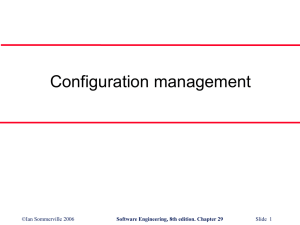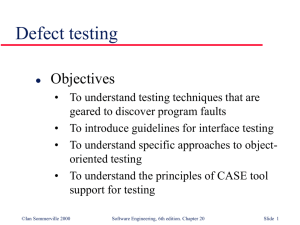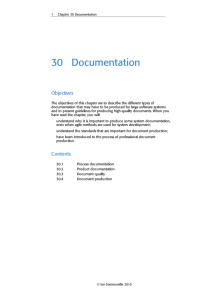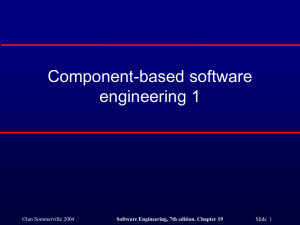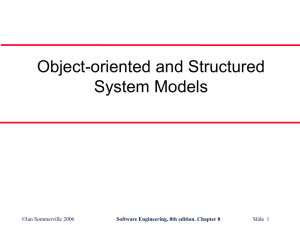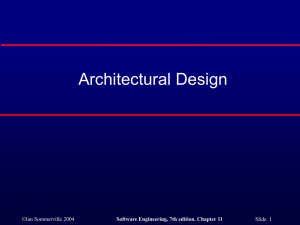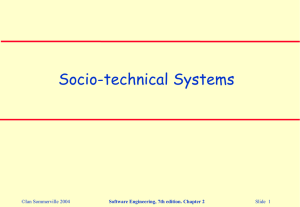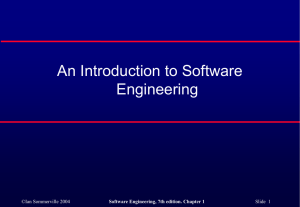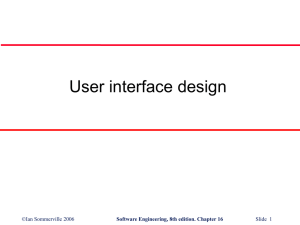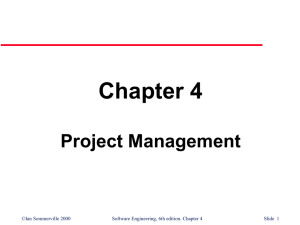Software Requirements: Definition & Specifications
advertisement
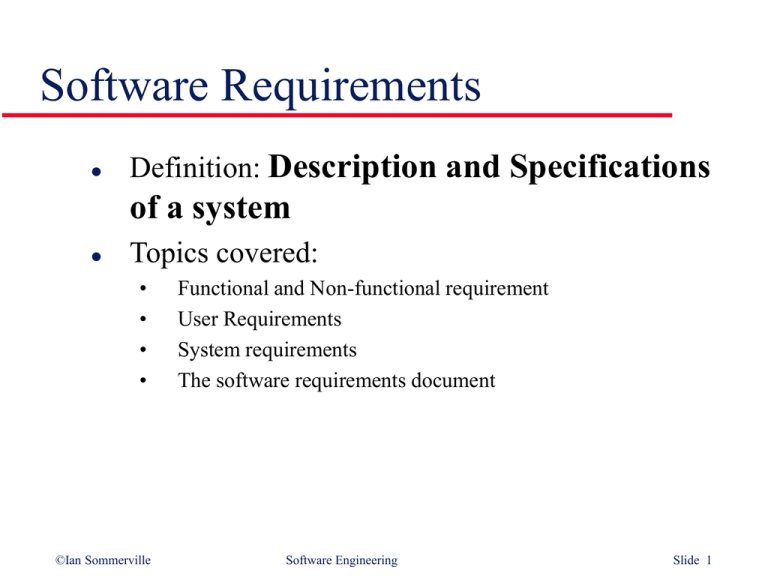
Software Requirements
Definition: Description and Specifications
of a system
Topics covered:
•
•
•
•
©Ian Sommerville
Functional and Non-functional requirement
User Requirements
System requirements
The software requirements document
Software Engineering
Slide 1
Software Requirements
The process of establishing the services that the customer
requires from a system and the constraints under which it
operates and is developed
Requirements may be functional or non-functional
•
•
©Ian Sommerville
Functional requirements describe system services or functions
Non-functional requirements is a constraint on the system or on
the development process
Software Engineering
Slide 2
What is a requirement?
It may range from a high-level abstract statement of a
service or of a system constraint to a detailed
mathematical functional specification
This is inevitable as requirements may serve a dual
function
•
•
•
©Ian Sommerville
May be the basis for a bid for a contract - therefore must be open to
interpretation
May be the basis for the contract itself - therefore must be defined in
detail
Both these statements may be called requirements
Software Engineering
Slide 3
Types of requirements
User requirements
•
System requirements
•
Statements in natural language (NL) plus diagrams of the services the
system provides and its operational constraints. Written for customers
A structured document setting out detailed descriptions of the system
services. Written as a contract between client and contractor
Software specification
•
©Ian Sommerville
A detailed software description which can serve as a basis for a design or
implementation. Written for developers
Software Engineering
Slide 4
Requirements Targets
User
Requirements
System
Requirements
Software
Specification
©Ian Sommerville
Client Managers
System end-users
Contract managers
System architects
System end-users
Client engineers
System architects
Software developers
Client engineers
System architects
Software Engineering Software developers
Slide 5
Requirements Types:
1.
2.
3.
Functional requirements: services the system
should provide
Non-functional requirements: constraints on the
services of functions offered by the system. e.g.
speed, time to market
Domain requirements: related to the application
domain of the system (may be functional or nonfunctional requirements)
©Ian Sommerville
Software Engineering
Slide 6
Functional requirements
Functionality or services that the system is
expected to provide.
Functional requirements may also explicitly state
what the system shouldn’t do.
Functional requirements specification should be:
•
•
©Ian Sommerville
Complete: All services required by the user should be defined
Consistent: should not have contradictory definition (also avoid
ambiguity don’t leave room for different interpretations)
Software Engineering
Slide 7
Non-Functional requirements
Requirements that are not directly concerned with
the specific functions delivered by the system
Typically relate to the system as a whole rather
than the individual system features
Often could be deciding factor on the survival of
the system (e.g. reliability, cost, response time)
©Ian Sommerville
Software Engineering
Slide 8
Non-Functional requirements
classifications:
Non-Functional
Requirements
Product requirements
External requirements
•Efficiency
•Reliability
•Portability
•Usability
•Performance
•Space
©Ian Sommerville
•Interoperability
Organizational requirements
•Delivery
•Implementation
•Standards
Software Engineering
•Ethics
•Legislative
•Privacy
•Safety
Slide 9
Domain requirements
Domain requirements are derived from the application
domain of the system rather than from the specific needs
of the system users.
May be new functional requirements, constrain existing
requirements or set out how particular computation must
take place.
Example: tolerance level of landing gear on an aircraft
(different on dirt, asphalt, water), or what happens to fiber
optics line in case of sever weather during winter
Olympics (Only domain-area experts know)
©Ian Sommerville
Software Engineering
Slide 10
Problems with natural language
Lack of clarity
•
Requirements confusion
•
Several different requirements may be expressed together
Ambiguity
•
Functional and non-functional requirements tend to be mixed-up
Requirements amalgamation
•
Precision is difficult without making the document difficult to read
The readers and writers of the requirement must interpret the same
words in the same way. NL is naturally ambiguous so this is very
difficult
Over-flexibility
•
©Ian Sommerville
The same thing may be said in a number of different ways in the
specification
Software Engineering
Slide 11
Alternatives to NL specification
Structured Natural language (via standard forms
& templates)
Program Description Language (PDL)
Use-Cases (scenario-based technique)
Mathematical specification (notations based on
mathematical concepts such as finite-state
machines or set.)
©Ian Sommerville
Software Engineering
Slide 12
Structured language specifications
A limited form of natural language may be used
to express requirements
This removes some of the problems resulting
from ambiguity and flexibility and imposes a
degree of uniformity on a specification
Often best supported using a form-based
approach
©Ian Sommerville
Software Engineering
Slide 13
Form-based specification
ECLIPSE/Workstation/Tools/DE/FS/3.5.1
Function:
Add node
Description: Adds a node to an existing design.
Inputs:
Node type, Node Position
Outputs:
Design identifier
Pre/Post conditions:
Other attributes:
Definition: ECLIPSE/Workstation/Tools/DE/RD/3.5.1
©Ian Sommerville
Software Engineering
Slide 14
PDL-based requirements definition
Requirements may be defined operationally using a
language like a programming language but with
more flexibility of expression
Most appropriate in two situations
•
•
•
©Ian Sommerville
Where an operation is specified as a sequence of actions and the
order is important
When hardware and software interfaces have to be specified
Example: ATM machine
Software Engineering
Slide 15
PDL disadvantages
PDL may not be sufficiently expressive to
express the system functionality in an
understandable way
Notation is only understandable to people with
programming language knowledge
The requirement may be taken as a design
specification rather than a model to help
understand the system
©Ian Sommerville
Software Engineering
Slide 16
ATM Specification: a PDL example
Class ATM {
// declaration here
public static void main (string args[]) InvalidCard {
try {
thisCard.read(); //may throw Invalid card
exception
pin = KeyPaD.READpIN(); attempts = 1;
While (!thisCard.pin.equal(pin) & attempts < 4)
pin = KeyPad.readPin(); attempts += 1;
.
.
.
©Ian Sommerville
Software Engineering
Slide 17
The requirements document
The requirements document is the official
statement of what is required of the system
developers
Should include both a definition and a
specification of requirements
It is NOT a design document. As far as possible,
it should set of WHAT the system should do
rather than HOW it should do it
©Ian Sommerville
Software Engineering
Slide 18
Requirements Engineering (RE)
processes
Processes used to discover, analyse and
validate system requirements
RE vary widely depending on the application domain, the
people involved and the organization developing the
requirements
However, there are a number of generic activities
common to all processes
•
•
•
•
©Ian Sommerville
Requirements elicitation
Requirements analysis
Requirements validation
Requirements management
Software Engineering
Slide 19
Problems of requirements analysis
Stakeholders don’t know what they really want
Stakeholders express requirements in their own terms
Different stakeholders may have conflicting requirements
Organizational and political factors may influence the
system requirements
The requirements change during the analysis process.
New stakeholders may emerge and the business
environment change
©Ian Sommerville
Software Engineering
Slide 20
Use cases
Use-cases are a scenario based technique in the
UML which identify the actors in an interaction
and which describe the interaction itself
A set of use cases should describe all possible
interactions with the system
Sequence diagrams may be used to add detail to
use-cases by showing the sequence of event
processing in the system
©Ian Sommerville
Software Engineering
Slide 21
Lending use-case
Lending services
Actor
©Ian Sommerville
Software Engineering
Slide 22
Library use-cases
Lending services
Library
User
User administration
Library
Staff
Supplier
©Ian Sommerville
Catalog services
Software Engineering
Slide 23
Ethnography
Ethnography is an observational technique that
can be used to understand social and
organizational requirements.
Developed in a project studying the air traffic
control process
Problem with ethnography is that it studies
existing practices which may have some
historical basis which is no longer relevant
©Ian Sommerville
Software Engineering
Slide 24
Enduring and volatile requirements
Enduring requirements. Stable requirements
derived from the core activity of the customer
organisation. E.g. a hospital will always have
doctors, nurses, etc. May be derived from domain
models
Volatile requirements. Requirements which
change during development or when the system is
in use. In a hospital, requirements derived from
health-care policy
©Ian Sommerville
Software Engineering
Slide 25
Classification of requirements
Mutable requirements
•
Emergent requirements
•
Requirements that emerge as understanding of the system
develops
Consequential requirements
•
Requirements that change due to the system’s environment
Requirements that result from the introduction of the computer
system
Compatibility requirements
•
©Ian Sommerville
Requirements that depend on other systems or organisational
processes
Software Engineering
Slide 26
